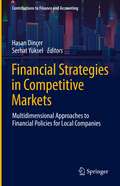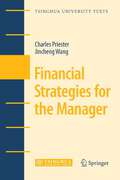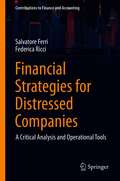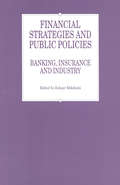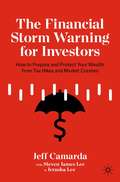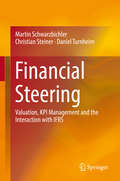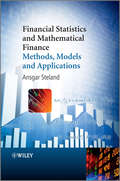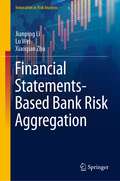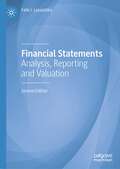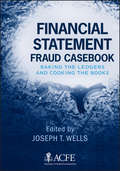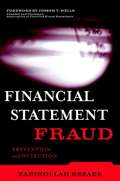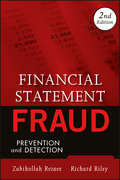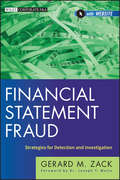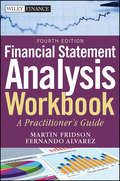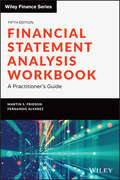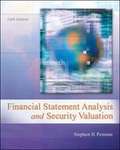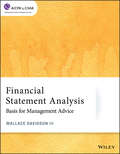- Table View
- List View
Financial Strategies in Competitive Markets: Multidimensional Approaches to Financial Policies for Local Companies (Contributions to Finance and Accounting)
by Hasan Dinçer Serhat YükselAs globalization continues to rapidly evolve, economic borders between countries have practically disappeared. One effect is that nowadays companies can access new markets by investing in other countries. This offers an important advantage especially for international and large-scale companies. However, one result is the increased market competition. Small-scale local firms and SMEs have to compete with international firms and corporations that have significantly more resources. This competitive environment jeopardizes the sustainability of the smaller companies, which often are driven out of business by the more powerful global players. This book discusses financial strategies for small and middle size companies to increase their competitiveness in the global markets.
Financial Strategies for the Manager (Tsinghua University Texts)
by Charles Priester Jincheng WangPart of Tsinghua University Texts, Financial Strategies for the Manager includes a range of financial management issues such as financial statement analysis, a systematic approach to financial performance appraisal, liquidity management and sales growth, working capital management, budgeting, foreign exchange and interest rate risk management, and a most useful tool not normally understood – EVA. The book is written in a concise and accessible style, minimizing the use of the technical jargon and complicated mathematical formulae. Included exercises enhance student learning and examples bolster ability to understand and use concepts in day-to-day situations. The material was originally developed for a large corporate client in the telecommunications business to assist non-financial managers in understanding financial theories in a practical way. It was expanded and revised into a text for a post-graduate course of the Asia/Pacific Management Co-operative Program, Capilano University, BC, Canada. Charles Priester is a professor at Capilano University of Canada; Jincheng Wang is a professor at the International Business School of Tianjin Foreign Studies University of China.
Financial Strategies for Distressed Companies: A Critical Analysis and Operational Tools (Contributions to Finance and Accounting)
by Salvatore Ferri Federica RicciThe financial markets have undergone a significant development process, both qualitatively and quantitatively, and partly induced by major pushes for globalization and deregulation. In this context, finance has taken on an increasingly central role for companies and is now on par with production and sales, which have always been the cornerstones of business management. The effects of these structural and functional changes are not limited to the way companies operate, but also imply a change in corporate cultures; one consequence of this phenomenon is the large percentage of managers from the world of finance at the top tiers of corporate organizations. Moreover, environmental turbulence has forced companies to increasingly face negative situations characterized by economic and financial imbalances that may require far-reaching strategic changes. The purpose of this book, therefore, is to investigate the possible financial strategies that companies in distress can adopt; in this regard, it approaches financial strategies as opportunities to resolve and prevent difficult situations for the company. After having systematized the financial strategies and policies used in the governance of companies, the book analyzes both crises and turnaround processes, describing the path until the financial balance is restored. Finally, the authors analyze essential tools for the financial management of companies in trouble, focusing in particular on operational tools for managing the crisis, the recovery plan, and its monitoring.
Financial Strategies and Public Policies: Banking, Insurance and Industry
by Zuhayr Mikdashi Otto Stich Pierre LanguetinPresents the policies and strategies of a wide-ranging group of ministerial personalities, central bankers, regulators and chief or senior executives of major financial and industrial groups. Their vision of the future is based on their high-level experience.
The Financial Storm Warning for Investors: How to Prepare and Protect Your Wealth from Tax Hikes and Market Crashes
by Jeff Camarda Steven James Lee Jerusha LeeIs an investors’ “perfect storm” brewing? If you’re not careful, it could sweep your wealth away. Long-dormant inflation looks to be catching fire. A stock market in overdrive may crash and burn for years. And taxes to fund deficits and social programs look to be rising to punishing levels not seen in a generation. This triple threat could mean a financial apocalypse from which many investors won’t ever recover. Getting straight talk on smart wealth management has never been more critical. With Social Security and Medicare tracking to go belly-up in a few short years, there will be dire consequences for millions. Already-retired boomers, living far longer than ever expected, will strain government resources and risk running out of money. Who will pay for it all? Without smart planning, your taxes may rise to confiscatory levels, sapping net worth and lifestyle quality. Your retirement lifestyle and legacy for your kids could get crushed. Some may never be able to retire.Investors and savers of every age and stripe will want to pay careful attention to the concentrated wisdom in this book and take proactive steps to protect themselves while there’s still time.
Financial Steering: Valuation, KPI Management and the Interaction with IFRS
by Martin Schwarzbichler Christian Steiner Daniel TurnheimThis book is a guide to how financial steering is designed, measured and implemented with a special focus on the energy industry. The authors offer an overview of and practical insights into the links between financial steering and accounting, and the temporary cycles of investment, divestment, return and loss, market highs and lows that form the framework of the entire energy industry across all value chain stages. The faster and the larger the cash cycles of investments and their returns, the greater not only the value created, but also the potential loss if the financial steering is not properly designed and managed. Value and value generation require an understanding of how value is both defined and measured in both and how the business/project economics model of a company works – financial steering provides this. Further, the book also discusses accounting topics such as impairments, new IFRS standards and the impact of accounting on key performance indicators of financial steering, which are associated with these investment decision valuations. The combination of accounting with the cash flow perspective provides a complete understanding of selected practical topics of financial steering which are explained in detail in a large number of examples and case studies. The book is intended for a wide range of finance/controlling/treasury/accounting professionals and students. It is written in practical and simple terms to outline the financial steering concept and to bring it to life in daily work and in the decision making process for financial steering. All illustrated concepts are in the same manner relevant and applicable to all other asset-intense industry sectors and their financial steering processes.
Financial Statistics and Mathematical Finance: Methods, Models and Applications
by Ansgar StelandMathematical finance has grown into a huge area of research which requires a lot of care and a large number of sophisticated mathematical tools. Mathematically rigorous and yet accessible to advanced level practitioners and mathematicians alike, it considers various aspects of the application of statistical methods in finance and illustrates some of the many ways that statistical tools are used in financial applications. Financial Statistics and Mathematical Finance: Provides an introduction to the basics of financial statistics and mathematical finance. Explains the use and importance of statistical methods in econometrics and financial engineering. Illustrates the importance of derivatives and calculus to aid understanding in methods and results. Looks at advanced topics such as martingale theory, stochastic processes and stochastic integration. Features examples throughout to illustrate applications in mathematical and statistical finance. Is supported by an accompanying website featuring R code and data sets. Financial Statistics and Mathematical Finance introduces the financial methodology and the relevant mathematical tools in a style that is both mathematically rigorous and yet accessible to advanced level practitioners and mathematicians alike, both graduate students and researchers in statistics, finance, econometrics and business administration will benefit from this book.
Financial Statistics and Mathematical Finance: Methods, Models and Applications
by Ansgar StelandMathematical finance has grown into a huge area of research which requires a lot of care and a large number of sophisticated mathematical tools. Mathematically rigorous and yet accessible to advanced level practitioners and mathematicians alike, it considers various aspects of the application of statistical methods in finance and illustrates some of the many ways that statistical tools are used in financial applications. Financial Statistics and Mathematical Finance: Provides an introduction to the basics of financial statistics and mathematical finance. Explains the use and importance of statistical methods in econometrics and financial engineering. Illustrates the importance of derivatives and calculus to aid understanding in methods and results. Looks at advanced topics such as martingale theory, stochastic processes and stochastic integration. Features examples throughout to illustrate applications in mathematical and statistical finance. Is supported by an accompanying website featuring R code and data sets. Financial Statistics and Mathematical Finance introduces the financial methodology and the relevant mathematical tools in a style that is both mathematically rigorous and yet accessible to advanced level practitioners and mathematicians alike, both graduate students and researchers in statistics, finance, econometrics and business administration will benefit from this book.
Financial Statements-Based Bank Risk Aggregation (Innovation in Risk Analysis)
by Jianping Li Lu Wei Xiaoqian ZhuThis book proposes a bank risk aggregation framework based on financial statements. Specifically, bank risk aggregation is of great importance to maintain stable operation of banking industry and prevent financial crisis. A major obstacle to bank risk management is the problem of data shortage, which makes many quantitative risk aggregation approaches typically fail. Recently, to overcome the problem of inaccurate total risk results caused by the shortage of risk data, some researchers have proposed a series of financial statements-based bank risk aggregation approaches. However, the existing studies have drawbacks of low frequency and time lag of financial statements data and usually ignore off-balance sheet business risk in bank risk aggregation. Thus, by reviewing the research progress in bank risk aggregation based on financial statements and improving the drawbacks of existing methods, this book proposes a bank risk aggregation framework based on financial statements. It makes full use of information recorded in financial statements, including income statement, on- and off-balance sheet assets, and textual risk disclosures, which solves the problem of data shortage in bank risk aggregation to some extent and improves the reliability and rationality of bank risk aggregation results. This book not only improves the theoretical studies of bank risk aggregation, but also provides an important support for the capital allocation of the banking industry in practice. Thus, this book has theoretical and practical importance for bank managers and researchers of bank risk management.
Financial Statements: Analysis and Reporting
by Felix I. LessamboThrough a mixture of concepts and examples, this book demystifies the variety of elements of financial accounting and uncovers the need-to-know information for certification in this field. This book covers the two aspects of financial statement analysis, namely quantitative and non-quantitative analysis. Concluding with helpful case studies, the book will appeal to students and academics of financial accounting.
Financial Statements: Analysis, Reporting and Valuation
by Felix I. LessamboThrough a mixture of concepts and examples, the second edition of this book demystifies the variety of elements of financial accounting and uncovers the need-to-know information for certification in this field. This book covers the two aspects of financial statement analysis, namely quantitative and non-quantitative analysis. Unique to the second edition, the book will also cover Non-GAA- metrics and valuation accounting. Concluding with helpful and updated case studies, the book will appeal to students and academics of financial accounting.
Financial Statement Fraud Casebook: Baking the Ledgers and Cooking the Books
by Joseph T. WellsA comprehensive look at financial statement fraud from the experts who actually investigated them This collection of revealing case studies sheds clear insights into the dark corners of financial statement fraud. Includes cases submitted by fraud examiners across industries and throughout the world Fascinating cases hand-picked and edited by Joseph T. Wells, the founder and Chairman of the world's leading anti-fraud organization ? the Association of Certified Fraud Examiners (ACFE) ? and author of Corporate Fraud Handbook Outlines how each fraud was engineered, how it was investigated and how the perpetrators were brought to justice Providing an insider's look at fraud, Financial Statement Fraud Casebook illuminates the combination of timing, teamwork and vision necessary to understand financial statement fraud and prevent it from happening in the first place.
Financial Statement Fraud Casebook: Baking the Ledgers and Cooking the Books
by Joseph T. WellsA comprehensive look at financial statement fraud from the experts who actually investigated them This collection of revealing case studies sheds clear insights into the dark corners of financial statement fraud. Includes cases submitted by fraud examiners across industries and throughout the world Fascinating cases hand-picked and edited by Joseph T. Wells, the founder and Chairman of the world's leading anti-fraud organization ? the Association of Certified Fraud Examiners (ACFE) ? and author of Corporate Fraud Handbook Outlines how each fraud was engineered, how it was investigated and how the perpetrators were brought to justice Providing an insider's look at fraud, Financial Statement Fraud Casebook illuminates the combination of timing, teamwork and vision necessary to understand financial statement fraud and prevent it from happening in the first place.
Financial Statement Fraud: Prevention and Detection
by Zabihollah RezaeeHigh profile cases of financial statement fraud have been dominating the news recently, causing people to question the accuracy of the financial information made available by companies. This book covers the roles and responsibilities associated with preventing and detecting financial statement fraud, including current developments and professional activities intended to reduce the occurrences of fraudulent financial reporting. It discusses the failures involved in the Enron collapse and includes a Forward by Joseph T. Wells from the Association of Certified Fraud Examiners. This books provides an invaluable context for understanding financial statement fraud.
Financial Statement Fraud: Prevention and Detection
by Zabihollah Rezaee Richard RileyPractical examples, sample reports, best practices and recommendations to help you deter, detect, and prevent financial statement fraud Financial statement fraud (FSF) continues to be a major challenge for organizations worldwide. Financial Statement Fraud: Prevention and Detection, Second Edition is a superior reference providing you with an up-to-date understanding of financial statement fraud, including its deterrence, prevention, and early detection. You will find A clear description of roles and responsibilities of all those involved in corporate governance and the financial reporting process to improve the quality, reliability and transparency of financial information. Sample reports, examples, and documents that promote a real-world understanding of incentives, opportunities, and rationalizations Emerging corporate governance reforms in the post-SOX era, including provisions of the SOX Act, global regulations and best practices, ethical considerations, and corporate governance principles Practical examples and real-world "how did this happen" discussions that provide valuable insight for corporate directors and executives, auditors, managers, supervisory personnel and other professionals saddled with anti-fraud responsibilities Expert advice from the author of Corporate Governance and Ethics and coauthor of the forthcoming Wiley textbook, White Collar Crime, Fraud Examination and Financial Forensics Financial Statement Fraud, Second Edition contains recommendations from the SEC Advisory Committee to reduce the complexity of the financial reporting process and improving the quality of financial reports.
Financial Statement Fraud: Prevention and Detection
by Zabihollah Rezaee Richard RileyPractical examples, sample reports, best practices and recommendations to help you deter, detect, and prevent financial statement fraud Financial statement fraud (FSF) continues to be a major challenge for organizations worldwide. Financial Statement Fraud: Prevention and Detection, Second Edition is a superior reference providing you with an up-to-date understanding of financial statement fraud, including its deterrence, prevention, and early detection. You will find A clear description of roles and responsibilities of all those involved in corporate governance and the financial reporting process to improve the quality, reliability and transparency of financial information. Sample reports, examples, and documents that promote a real-world understanding of incentives, opportunities, and rationalizations Emerging corporate governance reforms in the post-SOX era, including provisions of the SOX Act, global regulations and best practices, ethical considerations, and corporate governance principles Practical examples and real-world "how did this happen" discussions that provide valuable insight for corporate directors and executives, auditors, managers, supervisory personnel and other professionals saddled with anti-fraud responsibilities Expert advice from the author of Corporate Governance and Ethics and coauthor of the forthcoming Wiley textbook, White Collar Crime, Fraud Examination and Financial Forensics Financial Statement Fraud, Second Edition contains recommendations from the SEC Advisory Committee to reduce the complexity of the financial reporting process and improving the quality of financial reports.
Financial Statement Fraud: Strategies for Detection and Investigation (Wiley Corporate F&A #632)
by Gerard M. ZackValuable guidance for staying one step ahead of financial statement fraud Financial statement fraud is one of the most costly types of fraud and can have a direct financial impact on businesses and individuals, as well as harm investor confidence in the markets. While publications exist on financial statement fraud and roles and responsibilities within companies, there is a need for a practical guide on the different schemes that are used and detection guidance for these schemes. Financial Statement Fraud: Strategies for Detection and Investigation fills that need. Describes every major and emerging type of financial statement fraud, using real-life cases to illustrate the schemes Explains the underlying accounting principles, citing both U.S. GAAP and IFRS that are violated when fraud is perpetrated Provides numerous ratios, red flags, and other techniques useful in detecting financial statement fraud schemes Accompanying website provides full-text copies of documents filed in connection with the cases that are cited as examples in the book, allowing the reader to explore details of each case further Straightforward and insightful, Financial Statement Fraud provides comprehensive coverage on the different ways financial statement fraud is perpetrated, including those that capitalize on the most recent accounting standards developments, such as fair value issues.
Financial Statement Fraud: Strategies for Detection and Investigation (Wiley Corporate F&A)
by Gerard M. ZackValuable guidance for staying one step ahead of financial statement fraud Financial statement fraud is one of the most costly types of fraud and can have a direct financial impact on businesses and individuals, as well as harm investor confidence in the markets. While publications exist on financial statement fraud and roles and responsibilities within companies, there is a need for a practical guide on the different schemes that are used and detection guidance for these schemes. Financial Statement Fraud: Strategies for Detection and Investigation fills that need. Describes every major and emerging type of financial statement fraud, using real-life cases to illustrate the schemes Explains the underlying accounting principles, citing both U.S. GAAP and IFRS that are violated when fraud is perpetrated Provides numerous ratios, red flags, and other techniques useful in detecting financial statement fraud schemes Accompanying website provides full-text copies of documents filed in connection with the cases that are cited as examples in the book, allowing the reader to explore details of each case further Straightforward and insightful, Financial Statement Fraud provides comprehensive coverage on the different ways financial statement fraud is perpetrated, including those that capitalize on the most recent accounting standards developments, such as fair value issues.
Financial Statement Analysis Workbook: A Practitioner's Guide (Wiley Finance #599)
by Martin S. Fridson Fernando AlvarezAll too often, financial statements conceal more than they reveal. Even after the recent economic crisis, those analyzing financial statements face serious new concerns and challenges. The Fourth Edition of Financial Statement Analysis skillfully puts this discipline in perspective, and now, with this companion Workbook, you can hone your skills and test the knowledge you've gained from the actual text, before putting them to work in real-world situations. Question-and-answer sections within this Workbook correspond to each chapter of Financial Statement Analysis, Fourth Edition. Part One (Questions) provides chapter-by-chapter fill-in-the-blank questions, as well as financial statement and computational exercises. They are designed to be thought-provoking and require analysis and synthesis of the concepts covered in the book. The answers to all questions, which can be found in Part Two, are provided in boldfaced italic type in order to facilitate the checking of answers and comprehension of material. By enhancing your understanding of financial statement analysis, you can begin to undertake genuine, goal-oriented analysis and prepare for the practical challenges of contemporary business. This reliable resource will help you achieve such a difficult goal and allow you to make more informed decisions—whether you're evaluating a company's stock price or determining valuations for a merger or acquisition.
Financial Statement Analysis Workbook: A Practitioner's Guide (Wiley Finance #599)
by Martin S. Fridson Fernando AlvarezAll too often, financial statements conceal more than they reveal. Even after the recent economic crisis, those analyzing financial statements face serious new concerns and challenges. The Fourth Edition of Financial Statement Analysis skillfully puts this discipline in perspective, and now, with this companion Workbook, you can hone your skills and test the knowledge you've gained from the actual text, before putting them to work in real-world situations. Question-and-answer sections within this Workbook correspond to each chapter of Financial Statement Analysis, Fourth Edition. Part One (Questions) provides chapter-by-chapter fill-in-the-blank questions, as well as financial statement and computational exercises. They are designed to be thought-provoking and require analysis and synthesis of the concepts covered in the book. The answers to all questions, which can be found in Part Two, are provided in boldfaced italic type in order to facilitate the checking of answers and comprehension of material. By enhancing your understanding of financial statement analysis, you can begin to undertake genuine, goal-oriented analysis and prepare for the practical challenges of contemporary business. This reliable resource will help you achieve such a difficult goal and allow you to make more informed decisions—whether you're evaluating a company's stock price or determining valuations for a merger or acquisition.
Financial Statement Analysis Workbook: A Practitioner's Guide (Wiley Finance)
by Martin S. Fridson Fernando AlvarezThe helpful workbook to help practice assessing financial statements Financial statement analysis is essential as part of any well-organized financial portfolio. As a companion piece, Financial Statement Analysis Workbook: A Practitioner's Guide allows readers the opportunity to test and hone the skills put forward in Martin Fridson and Fernando Alvarez's Financial Statement Analysis, a resource devoted to providing the analytical framework necessary to make sense of the sometimes misleading numbers put forth by companies. Scrutinizing financial statements allows one to, for example, evaluate a company&’s stock price or determine merger or acquisition valuations. The Financial Statement Analysis Workbook, then, provides a pathway to become familiar with these methodologies in order to be prepared to use them in real-world scenarios. With the skills provided within, you can begin to undertake goal-oriented preparation for the practical challenges of contemporary business, and feel confident in your financial decision-making. This is aided by: Question-and-answer sections within this Workbook correspond to each chapter of Financial Statement Analysis Financial statement and computational exercises designed to require analysis and synthesis of concepts covered in the core text A full list of answers in the second half of the book that help explain pitfalls within the questions An essential tool for professional analysts, investors, and students, Financial Statement Analysis Workbook offers the perfect opportunity to help turn theory into reality.
Financial Statement Analysis Workbook: A Practitioner's Guide (Wiley Finance #79)
by Martin S. Fridson Fernando AlvarezThe helpful workbook to help practice assessing financial statements Financial statement analysis is essential as part of any well-organized financial portfolio. As a companion piece, Financial Statement Analysis Workbook: A Practitioner's Guide allows readers the opportunity to test and hone the skills put forward in Martin Fridson and Fernando Alvarez's Financial Statement Analysis, a resource devoted to providing the analytical framework necessary to make sense of the sometimes misleading numbers put forth by companies. Scrutinizing financial statements allows one to, for example, evaluate a company&’s stock price or determine merger or acquisition valuations. The Financial Statement Analysis Workbook, then, provides a pathway to become familiar with these methodologies in order to be prepared to use them in real-world scenarios. With the skills provided within, you can begin to undertake goal-oriented preparation for the practical challenges of contemporary business, and feel confident in your financial decision-making. This is aided by: Question-and-answer sections within this Workbook correspond to each chapter of Financial Statement Analysis Financial statement and computational exercises designed to require analysis and synthesis of concepts covered in the core text A full list of answers in the second half of the book that help explain pitfalls within the questions An essential tool for professional analysts, investors, and students, Financial Statement Analysis Workbook offers the perfect opportunity to help turn theory into reality.
Financial Statement Analysis And Security Valuation (PDF)
by Stephen H. PenmanValuation is at the heart of investing. A considerable part of the information for valuation is in the financial statements. Financial Statement Analysis and Security Valuation, 5 e by Stephen Penman shows students how to extract information from financial statements and use that data to value firms. The 5th edition shows how to handle the accounting in financial statements and use the financial statements as a lens to view a business and assess the value it generates.
Financial Statement Analysis: Basis for Management Advice (AICPA)
by Wallace Davidson IIIThis book presents financial statements as a set of dynamic instruments that can be used for accurate, relevant, and timely financial decisions. It focuses on the economic and financial conditions that cause statements to change and discover how businesses can manage liquidity, debt, and profitability. Plus, explore effect ratios, causal ratios, pro forma analysis, sustainable growth, and much more. Key topics covered include: valuation techniques, effect ratios, DuPont system for analyzing profitability, causal analysis. how to conduct a financial statement analysis, users of financial statements, forecasting sustainable growth, and bankruptcy prediction models.
Financial Statement Analysis: Basis for Management Advice (AICPA)
by Wallace Davidson IIIThis book presents financial statements as a set of dynamic instruments that can be used for accurate, relevant, and timely financial decisions. It focuses on the economic and financial conditions that cause statements to change and discover how businesses can manage liquidity, debt, and profitability. Plus, explore effect ratios, causal ratios, pro forma analysis, sustainable growth, and much more. Key topics covered include: valuation techniques, effect ratios, DuPont system for analyzing profitability, causal analysis. how to conduct a financial statement analysis, users of financial statements, forecasting sustainable growth, and bankruptcy prediction models.
